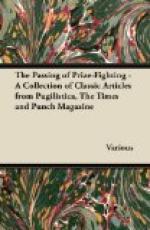She had me there. I confessed that I did not know.
“It was a brown wind,” she decided, impatient at my lack of resource, and slapped a wet typhoon of madder on the page. There was no more doubt about the wind.
“And is the picture finished now?” I asked her.
“No, it isn’t finished. I haven’t drawn the pookin yet.”
The pookin is a confusion in the mind of Priscilla between a pelican and a toucan, because she saw them both for the first time on the same day. In this case it consisted of an indigo splodge and a long red bar cutting right through the brown wind and penetrating deeply into the yellow sun.
“It had a very long beak,” observed Priscilla.
“It had,” I agreed.
I am no stickler for commonplace colours or conventional shapes in a work of art, but I do like things to be recognisable; to know, for instance, when a thing is meant to be a man and when it is meant to be a boat, and when it is meant to be a pookin and when it is meant to be a sun. The art of Priscilla seems to me to satisfy this test much better than that of many of our modern maestri. Strictly representational it may not be, but there are none of your whorls and cylinders and angles and what nots.
But I also insist that a work of art should appeal to the imagination as well as to the eye, and there seemed to me details about this picture that needed clearing up.
“Where were these men going to, Priscilla?” I asked.
“They was going to Wurvin,” she answered in the tone of a mother who instructs her child. “And what do you think they was going to do there?”
“I don’t know.”
“They was going to see Auntie Isabel.”
“And what did they do then?”
“They had dinner,” she cried enthusiastically. “And do you know what they did after dinner?”
“I don’t.”
“They went on the Front to see the fire-escape.”
It seemed to me now that the conception was mellow, rounded and complete. It had all the haunting mystery and romance of the sea about it. It was reminiscent of the Ancient Mariner. It savoured of the books of Mr. CONRAD. It reminded me not a little of those strange visitations which come to quiet watering-places in the novels of Mr. H.G. WELLS. When I thought of those seven men—one, alas, disembodied—so strangely attired yet so careful of elementary hygiene, driven by that fierce typhoon, with that bird of portent in the skies, arriving suddenly with the salt of their Odyssey upon their brows at the beach of the genteel and respectable Sussex town, and visiting a perhaps slightly perturbed Auntie Isabel, and afterwards the fire-escape, I felt that here was the glimpse of the wild exotic adventure for which the hearts of all of us yearn. It left the cinema standing. It beat the magazine story to a frazzle.
“And who is the picture for, Priscilla?” I asked, when I had thoroughly steeped myself in the atmosphere.




